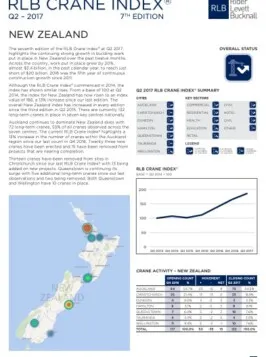An extraordinary 132 cranes stand tall across New Zealand’s cities (15 more than six months ago) as the result of the country’s ongoing construction boom, according to Rider Levett Bucknall’s Q2 2017 RLB Crane Index® released today.
‘In Auckland, in particular, strong economic growth driven by high inward migration and increasing tourist numbers, along with solid housing activity, manufacturing and consumer spending, has seen the rock star economy continuing to drive the construction industry, where demand is stretching the current supply,’ said Chris Haines, Director of RLB in Auckland.
Across the country, construction work put in place grew by 20%, almost $3.4 billion, in the past calendar year, to reach just under $20 billion. 2016 was the fifth year of continuous construction growth since 2011.
Auckland dominates with highest increase
Chris added, ‘Auckland continues to dominate New Zealand skies with 72 long-term cranes, 55% of all cranes observed across the seven key centres. The current RLB Crane Index® highlights a 13% increase in the number of cranes within the Auckland region since the last count in Q4 2016. Twenty-three new cranes have been erected and 15 have been removed from projects that are nearing completion.’
Sky City’s New Zealand International Convention Centre (NZICC) is one of Auckland’s largest construction sites, with 4 tower cranes now working on the country’s premier convention centre.
‘The Fletcher project is expected to create over 1,000 jobs during the construction phase and includes the NZICC facility, an adjacent laneway, expansion of underground car parking facilities and the development of a new 300-room, 5 star premium hotel. The project is due for completion in 2019,’ he said.
Chris concluded, ‘In this heated market, resource issues and supply chain constraints are evident, and tier one and two contractors and the large key subcontractors generally have most of their forward workload in place this year.’
Residential sector soaring
‘The lack of resources is increasing pricing in many areas and affecting delivery programs and time scales particularly on projects that are poorly planned around forecast cost and programme in the early stages. Combined with banks tightening up on some commercial and residential lending, there is an increased likelihood of some planned projects being delayed, deferred or shelved.’
With 43 cranes in total, Auckland’s residential sector continues to soar with a net increase of five cranes, after nine were removed and 15 new cranes have commenced on new residential and aged care projects. New cranes have been observed on projects at Alexandra Park, Browns Bay, Grey Lynn, Mt Wellington, One Tree Hill, Ponsonby, Remeura, Royal Oak, Eden Terrace, K Road, Mt Albert Rd, Parnell Road, Normanby Road, Sale Street and Victoria Street.
Auckland’s residential sector cranes account for 60% of the Auckland cranes, for 88% of all the residential cranes counted in New Zealand, and 33% of all the total cranes counted nationally. The residential count also includes the aged-care sector which has seen a recent growth in crane numbers. While the residential sector is dominant in Auckland, the proportion of residential cranes counted in Sydney and Melbourne are both far greater and are in excess of 85% of all cranes counted in these Australian cities.
Commercial sector also strong
Auckland’s commercial sector saw the addition of five cranes, while eight cranes continued on projects bringing the total count within the sector to 13. Commencements saw cranes being installed at two Manson’s commercial developments at 96 St Georges Bay Road, Parnell, Sale Street and 1 Broadway, Newmarket together with two cranes at Precinct Properties’ $681-million Commercial Bay project. The fixed tower crane installed there will eventually be the country’s highest at 225 metres.
Within the education sector, one crane was removed at AUT’s South M1 project, leaving four cranes within the sector. The only retail crane previously recorded was removed at the Bunnings site at Great North Road.
The hotel sector has seen a spike with a total of four new cranes at the new Sky City hotel and the Park Hyatt at the Wynyard Quarter site. A crane has been removed from the Accor Hotel conversion project in Custom Street.
Most sectors in Auckland remain very strong, and while the education and civil sectors have seen a recent reduction in crane activity, the forward pipeline of work remains significant in these sectors too.
Across New Zealand, residential is still the dominant sector with 49 cranes representing 37% of all cranes commissioned on both private residential and aged-care housing projects. The sector saw a net gain in crane numbers of six.
Commercial projects underway account for 35 cranes, up from 33 at the last count. This sector accounts for 27% of all cranes in New Zealand. Both the health and hotel sectors saw net gains across the country of five and three cranes respectively. Education projects nearing completion saw the sector fall by two cranes.
Christchurch second busiest construction city
With 25 cranes erected across its skyline, Christchurch remains the second busiest construction city in New Zealand. Thirteen cranes have been removed from sites in Christchurch with 13 being added on new projects representing the same level of total crane activity since the last RLB Crane Index at Q4 2016.
Activity on the new Christchurch Hospital has seen two new cranes commence on the Outpatients Building and an additional crane at the Acute Services Building taking the total count to four. The Health sector is now the equal largest sector within Christchurch with eight cranes. Additional projects that have added cranes since our last Index include the Forte Health expansion in Peterborough Street and the Health Research Education Facility in Oxford Terrace.
Both Wellington and Queenstown now have 10 long term cranes in place. Queenstown is continuing its surge with five additional long-term cranes since the firm’s last observations and two being removed. New Queenstown projects with cranes include the Wakatipu High School (2), an additional crane at Kawarau Bridge and a crane each at residential developments at Fernhill and Lakeside estate.
Hamilton increased their numbers again with eight cranes providing logistical support to projects underway up from six counted for the Q4 2016 index. Tauranga remains at four cranes. North Island building activity (excluding major regions) grew by 22% during 2016 with residential activity surging 40% whilst non-residential work fell by 7%.
Dunedin has seen the addition of three long term cranes from a zero count at our last Index. Two long term cranes are assisting in the development of student residences for the Otago Polytechnic and one long-term crane is in place at the University of Otago’s Commerce Building refurbishment with the tower crane at the Dental School likely at the end of April.
FURTHER INFORMATION:



